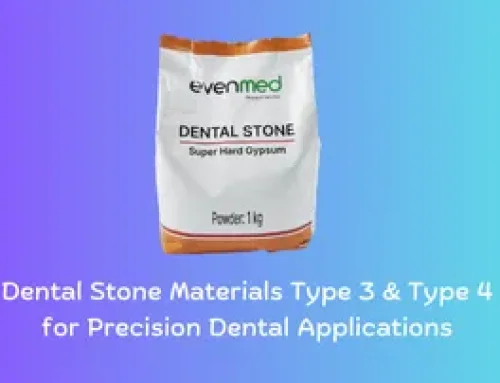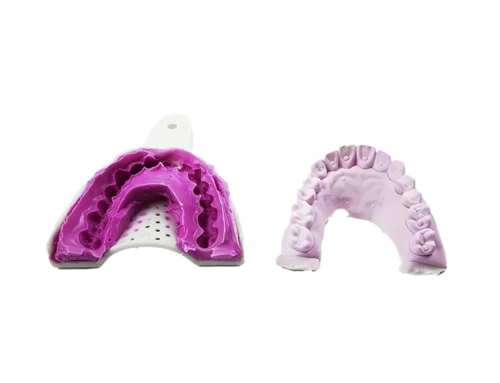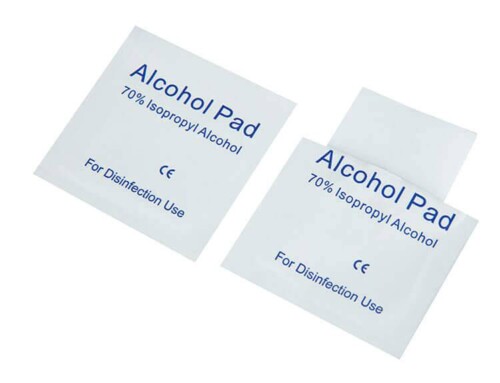What’s the Alginate Impression Material? Alginate impression material is a type of dental impression material that is commonly used in dentistry to create a negative mold of a patient’s teeth and gums. It is made from seaweed extract and is known for its ability to capture fine details and its quick setting time. Alginate impression material is often used in the first step of the dental impression process, where it is used to create a preliminary mold of the mouth that can be used to make a more detailed and accurate final impression. It is also commonly used for making temporary crowns and bridges. Because it is easy to use and relatively inexpensive, the alginate impression material is a popular choice among dental professionals.
Types of alginate impression material
There are several different types of alginate impression material, including regular set, fast set, and extra fast set. Regular set alginate impression material typically takes between 4 and 6 minutes to set, while fast set alginate impression material sets in 2 to 3 minutes, and extra fast set alginate impression material sets in less than 2 minutes. In addition to these different setting times, alginate impression material is also available in a variety of flavors, including mint, strawberry, and bubblegum, to make the impression-taking process more pleasant for patients. Some alginate impression materials are also available in a powder-free form to reduce the risk of airborne contamination.
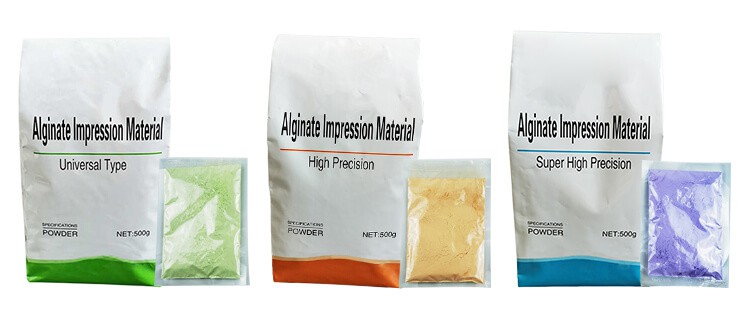
-
Dental alginate impression material
Dental alginate impression material is a type of impression material that is commonly used in dentistry to create a negative mold of a patient’s teeth and gums. It is made from seaweed extract and is known for its ability to capture fine details and its quick setting time. Alginate impression material is often used in the first step of the dental impression process, where it is used to create a preliminary mold of the mouth that can be used to make a more detailed and accurate final impression. It is also commonly used for making temporary crowns and bridges. Because it is easy to use and relatively inexpensive, the dental alginate impression material is a popular choice among dental professionals.
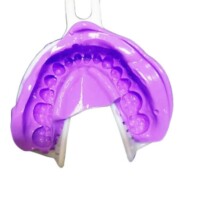
-
Casting alginate impression material
To cast an alginate impression material, you will need a few things:
- Alginate impression material
- A mixing bowl and a mixing spoon or spatula
- A measuring cup
- Water
- A tray or container to hold the impression material
To start, measure out the appropriate amount of alginate impression material and water according to the manufacturer’s instructions. Then, mix the material and water together in the mixing bowl until it forms a smooth, lump-free consistency.
Next, pour the mixed impression material into the tray or container and carefully place it in the mouth, making sure to fill all the desired areas. Gently press the material against the teeth and gums to ensure an accurate impression.
After the material has been set, carefully remove it from the mouth and let it cure according to the manufacturer’s instructions. Once it has fully cured, you can use the impression to cast a model of the teeth and gums.
It’s important to follow the manufacturer’s instructions carefully and to use the impression material within the recommended working time to ensure the best possible results.
Reference suggestions (Alginate Grams) , please check this link for reference: Alginate Impression Powder 3D Mold Casting
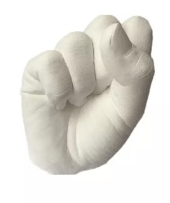
Composition of alginate impression material
Alginate impression material is made from a substance called alginate, which is derived from brown seaweed. When mixed with water, alginate forms a gel-like substance that is able to capture fine details and has a quick setting time. In addition to alginate, alginate impression material may also contain other ingredients such as fillers, stabilizers, and preservatives to improve its handling characteristics and increase its shelf life. Some alginate impression materials may also contain flavors to make the impression-taking process more pleasant for patients.
Main Composition (%w/w)
| Chemical name | CAS No. |
| Diatomite | 61790-53-2 |
| Calcium sulfate | 7778-18-9 |
| Sodium alginate | 9005-38-3 |
| Zinc oxide | 1314-13-2 |
| Disodium hexa fluoro titanate | 17116-13-1 |
| Talc | 14807-96-6 |
| Trisodium orthophosphate | 7601-54-9 |
| Note:CASNo.is Chemical Abstract Service Registry Number. | |
Technical Overview
| Chromatic Color Changing: | Light Green Powder > turns Pink when mixing > turns to Light Green |
| Mixing time: | Up to 1 minute, 30-40 seconds (allowing 20-30 seconds to get subject ready into the mixture for setting) |
| Starts to set at: | 2 minutes |
| Fully set at: | 3 – 4 minutes |
| Temperature: | 23°C/73°F(below 30°C) |
| Mixing Ratio: | 1500ml of 30°C Water to 500g of Alginate ( Ratio: 3/1) |
For more details, please check the TDS of alginate impression material: Alginate Impression Material Technical Data Sheet
Advantages of alginate impression material
There are several advantages of alginate impression material. One of the main advantages is its ability to capture fine details, which makes it ideal for creating accurate and detailed impressions of a patient’s teeth and gums. Alginate impression material is also quick-setting, which means that it can be used to make a preliminary mold of the mouth that can be used to make a more detailed and accurate final impression. In addition, the alginate impression material is relatively inexpensive and easy to use, which makes it a popular choice among dental professionals. Another advantage of alginate impression material is that it is biodegradable, which makes it environmentally friendly.
Disadvantages of alginate impression material
There are a few disadvantages of alginate impression material. One disadvantage is that it is not as durable as some other types of dental impression materials, such as polyether or silicone. This means that alginate impressions may not be suitable for long-term use or for making final restorations. Another disadvantage is that alginate impression material can become distorted or deformed if it comes into contact with moisture or heat, which can affect its accuracy and detail. Additionally, some people may be allergic to the ingredients in alginate impression material, which can cause irritation or discomfort. Finally, the alginate impression material is not suitable for use with some dental materials, such as acrylic resins, which can cause the alginate impression to disintegrate.
Alginate impression material properties
Alginate impression material is a type of dental impression material that is commonly used in dentistry to create a negative mold of a patient’s teeth and gums. It is made from seaweed extract and has several key properties that make it well-suited for use in dentistry. Some of the properties of alginate impression material include:
- Fast setting time: Alginate impression material sets quickly, typically in 2 to 6 minutes, depending on the type of material being used. This allows dental professionals to take impressions quickly and efficiently.
- Fine detail capture: Alginate impression material is able to capture fine details, such as the texture of the teeth and gums, which is important for creating accurate and detailed impressions.
- Pliability: Alginate impression material remains pliable and can be manipulated while it is setting, which allows dental professionals to make adjustments or corrections to the impression before it becomes hard and irreversible.
- Biodegradable: Alginate impression material is biodegradable, which makes it environmentally friendly.
- Easy to use: Alginate impression material is relatively easy to use and does not require specialized equipment or training.
These properties make alginate impression material a popular choice among dental professionals for creating dental impressions.
For other questions, you may also want to know.
How To Take Best Alginate Impressions?
To take the best alginate impressions, follow these steps:
- Make sure that the patient’s mouth is clean and dry before starting the impression process. Use a dry gauze pad or cotton roll to remove any excess moisture and debris from the teeth and gums.
- Mix the alginate impression material according to the manufacturer’s instructions. Use a plastic spatula or mixing pad to thoroughly mix the material until it has a smooth and creamy consistency.
- Load the mixed alginate impression material into a dental impression tray that is the appropriate size and shape for the patient’s mouth.
- Ask the patient to bite down on the impression tray, applying even pressure to ensure that the alginate impression material is evenly distributed and captures the details of the teeth and gums.
- Wait for the alginate impression material to set according to the manufacturer’s instructions. This typically takes between 2 and 6 minutes, depending on the type of alginate impression material being used.
- Once the alginate impression material has set, carefully remove the impression tray from the patient’s mouth. Use a scaler or other dental instrument to carefully remove any excess material from the teeth and gums.
- Place the alginate impression in a container filled with water to prevent it from drying out. This will help to preserve the impression and ensure that it retains its accuracy and detail.
- Use the alginate impression to make a more detailed and accurate final impression of the patient’s mouth. This can be done using a variety of different impression materials, such as dental stone or polyether.
By following these steps, you can take the best alginate impressions and create accurate and detailed mold of a patient’s teeth and gums.
How to Mix alginate impression material?
To mix alginate impression material, follow these steps:
- Gather the necessary materials, including the alginate impression material, mixing bowl, water, and mixing spatula or pad.
- Measure out the appropriate amount of alginate impression material according to the manufacturer’s instructions.
- Place the alginate impression material in the mixing bowl and add the recommended amount of water.
- Use the mixing spatula or pad to thoroughly mix the alginate impression material and water until it has a smooth and creamy consistency.
- Continue to mix the alginate impression material for the recommended amount of time, typically between 30 seconds and 1 minute.
- Once the alginate impression material is thoroughly mixed, it is ready to use.
It is important to follow the manufacturer’s instructions carefully when mixing alginate impression material to ensure that it is mixed properly and has the correct consistency for taking dental impressions.
What is the working time of alginate impression material?
The working time of alginate impression material varies depending on the type of material being used. Regular set alginate impression material typically has a working time of between 2 and 3 minutes, while fast set alginate impression material has a working time of around 1 minute. Extra fast set alginate impression material has an even shorter working time, typically less than 1 minute. The working time of alginate impression material refers to the amount of time that the material remains pliable and can be manipulated before it begins to set. Once the material has set, it is no longer possible to make adjustments or corrections to the impression.
What’s Alginate impression material SDS?
SDS (Safety Data Sheet) is a document that provides information about the hazards and safe handling of a chemical product, such as alginate impression material. SDS is also known as a Material Safety Data Sheet (MSDS). The MSDS for alginate impression material will contain information about the potential health and safety hazards associated with the product, as well as recommendations for safe handling, storage, and disposal. The SDS will also include information about the product’s ingredients, physical and chemical properties, and first aid measures in case of accidental exposure. It is important for dental professionals to carefully read and understand the MSDS for alginate impression material before using the product to ensure safe and effective use.
Even Medical alginate to make precious souvenirs or for dental use.
Even Medical Alginate Impression Powder allows you to create a variety of 3D molds. You can fill your mold with cast plaster, following the manufacturer’s directions for use.
Also, we can provide other grams or custom packaging. Please send us the inquiry.
Often use alginate? Why not inquire now to ensure you always have a steady supply of Even Medical Alginate on hand when you need it?


